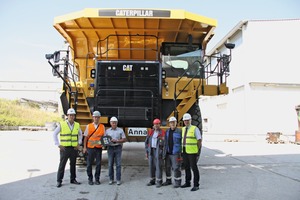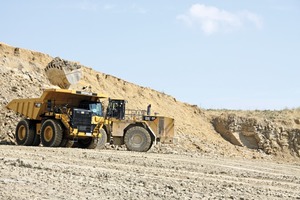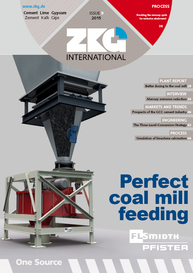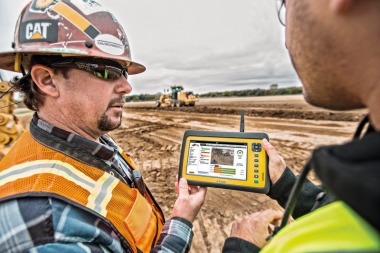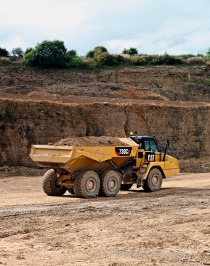Health and safety in lime quarrying
One occupational group constantly exposed to whole body vibrations are the drivers of construction machines. While they drive around on construction sites or in quarries day after day, their bodies are exposed to vibrations. Within the Schwenk group of companies, health and safety has long been a high priority, in fact the group’s latest investment in a Cat 777G off-highway dumper truck is part of its efforts to improve health and safety. The new off-road truck recently started operation at the group’s Allmendingen site (Fig. 1).
To protect the drivers against vibrations, in 2002, within the scope of the noise and vibration health and safety regulations, the EU released the 2002/44/EC directive of the European Parliament and the Council, which has been implemented in national legislation. Employers like Schwenk are obligated to eliminate or minimize both real and potential dangers caused by vibrations. For this reason, for each new construction machine, the company checks on the basis of a risk assessment how the machine vibrations can be reduced. The dumper truck forms part of a package of machines that Schwenk contracted from the Zeppelin branch in Ulm. The package comprises another 777G model, three Cat 775G dumper trucks and a Cat 992K wheel loader. Two dumpers with a rigid frame are intended for use at the Allmendingen site and three for Mergelstetten.
To determine the vibrations to which the operatives – for instance in the off-road trucks – are exposed and which impact their bodies, Schwenk acquired an additional measurement instrument. This will be used to record vibrations and the driver operation characteristics. Providing the vibrations don’t exceed a set limit, everything is good to go. Otherwise action must be taken. A sort of disk together with a sensor is installed on the driver’s seat and during the working time of eight hours and work process, it continuously measures the vibrational load. The vibrations are registered during the loading process, the drive to the crusher and the dumping process. In Allmendingen, new dumper truck is loaded from three main loading points, which constantly change with the progress of the extraction process. A RH120E excavator, a Cat 990H wheel loader and 992K feed the limestone raw material (Fig. 2). As a target, the machines must reach a throughput rate of 1600 t/h. That is the highest possible rate the crusher can handle.
But when is it clear whether mechanical vibrations are impacting health and possibly damaging it? Crucial are the vibration frequency, that is the time intervals in which the vibrations take place and the vibration amplitude, that is the intensity of the vibrations. Vibrations between 0.5 to 100 Hz are regarded as critical. Operators of the construction machines are exposed to whole body vibrations from one to 10 Hz, which generally act on the body through the bottom and therefore the spine, lumbar region and spinal discs, putting these under strain. From this, wear effects on muscles, skeleton and nervous system result, but other bodily functions such as blood circulation can be impaired. It is therefore important to instruct all employees at regular intervals with regards to health and safety, but also to eliminate sources of danger.
The group has introduced a series of measures to prevent health impacts and vibration-related diseases. This can, for example, be achieved with appropriate suspension and absorbers in the construction machines. A sprung operator’s seat with a three-point belt as installed in the Cat 777G makes a key contribution. So that the seat can take full effect, drivers should adjust the seat to their weight prior to starting the engine. But other features support the ergonomic design. The operating controls can be easily reached. A comfortably designed cab as in Cat 777G ultimately ensures that the driver of the construction machine can work for a relatively long time, without his health being impaired.
To tackle the problem at its root, it is important to reduce vibrations at the place of origin at all Schwenk sites. The vibrations can be caused, for example, by the uneven roads or tracks over which the construction machines have to drive. They have a direct influence on the intensity of the vibrational load. For that reason, the machine routes must be properly maintained. At the Allmendingen site, for example, wheel loaders fulfil duties in road construction or maintenance, when they are not busy in their main task of loading the dumper trucks. To avoid gradients in the roads, which otherwise the dumpers would have to negotiate on the trip to and from the crusher, an extra route was laid out in the quarry. From their many years of work experience, the Schwenk drivers who drive the big machines, like the Cat 777G dumper truck, around the quarry know that they should only drive over the terrain at appropriate speed and adapt their driving style to avoid vibrational load. Careful driving is a firm principle here, just as avoiding sudden braking or acceleration.
“We are changing our fleet of machines because we want to use state-of-the-art equipment, which offer higher capacity and have been further developed by the manufacturers,” Wolfgang Kuhnt explains. This was the case with the new Cat 777G, which has been reworked with regard to safety. Its braking behaviour, the traction control and the access to the driver’s cab in the new line of dumper trucks have been improved. So that the drivers really exhaust all technical possibilities the construction machines offer, when each new machine is commissioned, they receive special training.
//www.zeppelin-cat.de" target="_blank" >www.zeppelin-cat.de:www.zeppelin-cat.de

